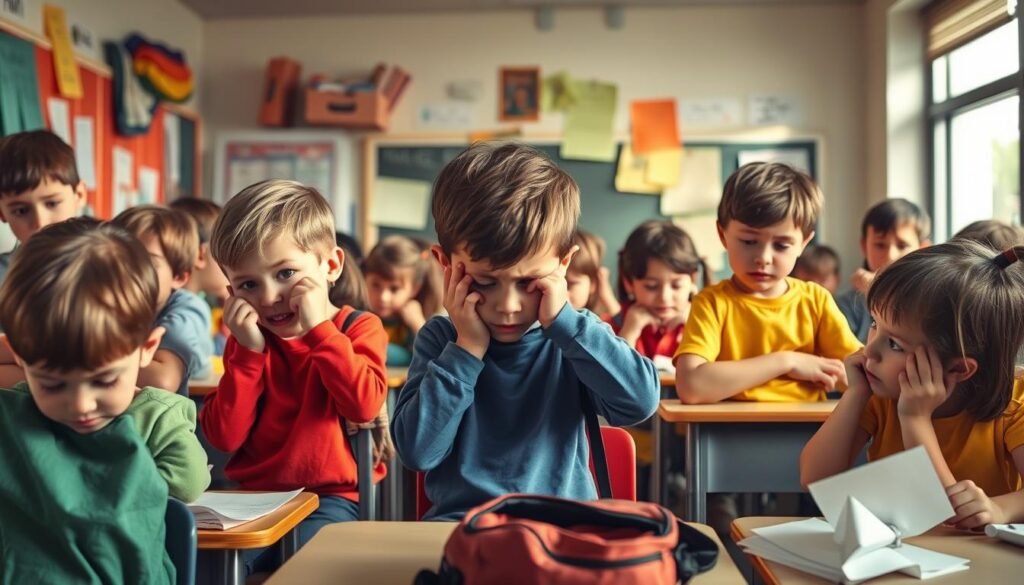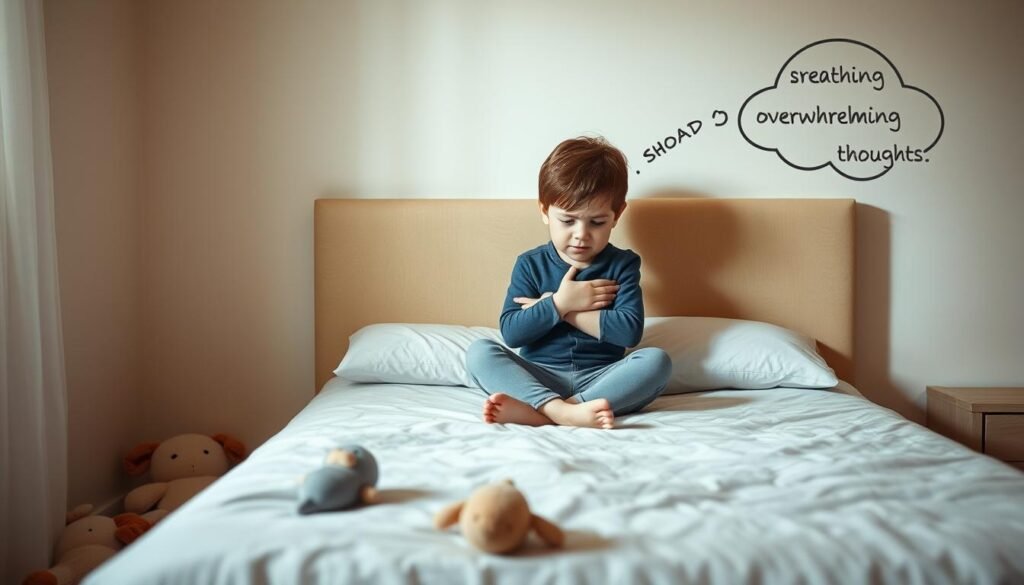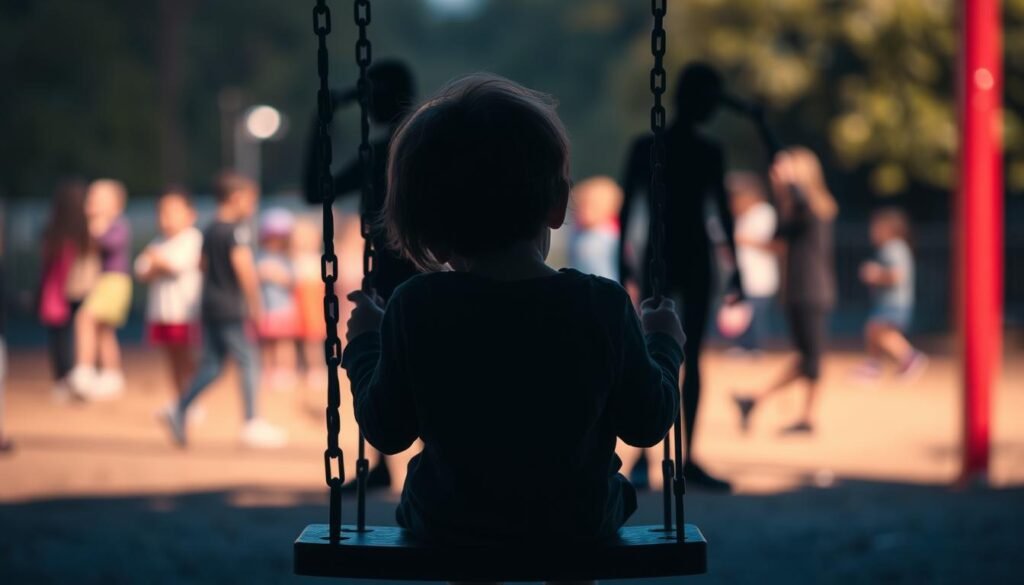About 8 to 11% of kids and teens have anxiety disorders that greatly impact their daily activities. This fact highlights the need to spot behavioral symptoms of anxiety in children. Often, signs of anxiety in kids are hidden by actions that seem like bad behavior or naughtiness. If a child remains worried for over six months, it could mean an anxiety disorder is developing.
Children with anxiety might show irritability, complain of physical problems, and act out, making it hard for them to make friends or do well in school. Knowing these childhood anxiety indicators is key for parents, caregivers, and teachers. Experts say getting help early can improve children’s lives with anxiety. For more info on how anxiety leads to trouble behaving, check out this useful link.
Key Takeaways
- Behavioral symptoms of anxiety can be misinterpreted as defiance.
- Recognizing signs early aids in effective intervention.
- Irritability and physical complaints are common anxiety symptoms.
- 8 to 11% of children experience anxiety that disrupts normal life.
- Academic and social performance can be greatly affected by anxiety.
Understanding Childhood Anxiety
Childhood anxiety covers feelings from mild worries to intense fear. It affects daily life significantly. Parents need to know the difference between normal fears and severe anxiety.
At about six months, separation anxiety shows early signs of anxiety in kids. This is a common start.
Many things cause anxiety in kids. Genetics is one, as parents see traits they had too. Childhood anxiety indicators can look like ADHD or autism. These show how the brain works differently.
Stressful events like divorce, bullying, or illness can make kids feel more anxious. Such events are triggers.
Anxiety doesn’t just stop after childhood. It continues into teen years, bringing challenges like depression and drug use. Observing behavioral clues is key to understanding childhood anxiety. Clues include excessive worry or avoiding friends.
Cognitive Behavioral Therapy (CBT) is effective for childhood anxiety. It helps change anxious thoughts. Sometimes, meds are used but with caution. Support from therapy is best with it.
Knowing about childhood anxiety helps parents support their kids better. Creating a stable and healthy environment is essential for their growth.
Common Anxiety Signs in Kids
Anxiety shows up differently in every child. It’s crucial to spot Common Anxiety Signs in Kids early. Kids might become more clingy, showing they’re scared of being apart. They could have nightmares or trouble sleeping too. Having a hard time focusing is another sign, which can affect their schoolwork.
Kids with anxiety might have sudden mood changes. This makes it tricky for parents to figure out what’s wrong. In places like school, they may keep to themselves or stay away from others. This behavior shows their discomfort in these settings.
Sometimes, kids complain about feeling sick, like having stomach or headaches, when they’re anxious. These complaints might not be due to actual illnesses. Anxiety can make kids start habits like biting their nails when they’re worried.
Families looking to understand more about childhood anxiety should seek out information and expert advice. A great starting point can be this guide.
| Signs of Anxiety | Description |
|---|---|
| Clinginess | Excessive need for reassurance or constant proximity to caregivers. |
| Sleep disturbances | Frequent nightmares or difficulty falling and staying asleep. |
| Difficulty concentrating | Inability to focus on tasks, often resulting in academic struggles. |
| Rapid mood swings | Sudden changes in emotional state, leading to irritability or withdrawal. |
| Avoidance behavior | Choosing to avoid social situations or activities that induce anxiety. |
| Physical complaints | Recurring reports of headaches or stomachaches without medical causes. |
Behavioral Symptoms of Anxiety in Children
Anxiety shows up in kids through different behaviors. These signs hint at the emotional challenges kids face. It’s crucial for adults close to them to notice these behaviors. This understanding helps adults support and guide children effectively.
Disruptive Behaviors as Anxiety Indicators
When kids feel anxious, they might act out. For instance, they may hit others, throw things, or have big tantrums. These behaviors often come from not knowing how to deal with fear and frustration. They suggest the child could be dealing with a deeper issue, like anxiety.
Emotional Outbursts and Anxiety Connections
Big emotional reactions can mean a child is dealing with lots of anxiety. A small problem can cause a huge response if they’re feeling overwhelmed. This might show they are scared of failing or being social. Parents helping their kids talk about these feelings is very helpful. For more tips, check out this resource.
Increased Irritability and Sensitivity
Feeling very irritable or sensitive can be a sign of anxiety in kids. They might overreact to feedback or changes in their day. As their worry grows, kids might pull back from friends and family. This can make it hard for them to get along with others.
| Behavioral Symptoms | Possible Causes | Recommended Actions |
|---|---|---|
| Disruptive Behaviors | Generalized Anxiety Disorder | Encourage emotional expression |
| Emotional Outbursts | Social Anxiety or Fear of Failure | Promote a supportive environment |
| Increased Irritability | Difficulty in Emotional Regulation | Practice relaxation techniques |
How Anxiety Affects School Performance
Anxiety in kids can hurt their school work and friendships. It’s key to know the signs of anxiety in children. This helps in giving them the right support. Teachers and parents need to understand these symptoms in school.
Classroom Disruption and Learning Challenges
Kids dealing with anxiety might disrupt class, affecting everyone’s learning. They might act out or show signs like nausea. This can make them miss school a lot.
Feeling anxious can make kids doubt themselves and avoid hard tasks. They might not join in discussions or answer questions. This can make them fall behind. Personal attention from teachers can really help.
Social Interaction Difficulties
Children with anxiety find social situations hard. They might avoid group work or fear tests. This fear can make them stay away from friends, making them feel more alone. Kids with separation anxiety might need to contact their parents a lot during school.
Anxiety becomes more common as kids get older. There’s a clear rise in anxiety from elementary to high school. It’s crucial to spot and help with these issues early on.

| Grade Level | Anxiety Prevalence (%) | Impact on Academic Performance |
|---|---|---|
| Elementary | 2.3% | Lower engagement in group activities, effects of social anxiety |
| Middle School | 7.9% | Challenges in test-taking, reluctance to interact with peers |
| High School | 15.9% | Increased risk of academic failure, high levels of performance anxiety |
Childhood Anxiety Indicators and Their Implications
It’s vital to recognize signs of anxiety in children early. Anxiety symptoms can vary, needing alertness from parents and educators. Some kids may feel slightly uncomfortable, while others face severe issues that affect their daily life.
Anxiety often starts in childhood or adolescence. It can show up as temporary fears or develop into major disorders. Sadly, about 30 percent of kids may have an anxiety disorder before adulthood. Yet, many don’t get the help they need.
Spotting anxiety in children is tough. Their fears can seem normal but may be more serious. Young children may fear being away from parents. Teens might struggle with social fears. Each age has different signs, making it tricky to figure out.
There are many criteria to identify anxiety disorders in kids, based on global guidelines. Knowing these helps caregivers see when anxiety might be a bigger issue. Fears like worrying about pets or household changes are common. But if these fears lead to serious problems, a specialist’s help is needed.
Ignoring signs of anxiety can have big consequences. If not addressed, childhood anxiety can continue into adulthood. It might even increase the risk of depression. Early help is key. Techniques like cognitive-behavioral therapy and support networks are effective. They promote better emotional health.
Physical Symptoms Associated with Anxiety
Kids often face physical issues along with emotional problems when they’re anxious. It’s important to see how these symptoms and Anxiety Symptoms in Children connect. This helps in giving help on time. Many times, parents think their kids are just not feeling well. But these signs might show bigger problems that need looking into.
Complaints of Aches and Illness
Many kids say they feel aches, like stomach pains or headaches, when anxious. These pains can make it hard for them to go to school or hang out with friends. The Centers for Disease Control and Prevention (CDC) says about 7.1 percent of kids from 3 to 17 have anxiety. This shows how common these Behavioral Symptoms of Anxiety in Children are.
Sleep Disturbances and Anxiety
Sleep problems often go hand in hand with anxiety in kids. They might have trouble sleeping, have bad dreams, or can’t stay asleep. These issues make Anxiety Symptoms in Children worse. They find it tough to focus or do everyday things. Helping them with bedtime routines can make a big difference in how they feel.

| Physical Symptom | Description | Impact |
|---|---|---|
| Stomach Aches | Frequent complaints of stomach pain, often without a clear physical cause. | Can lead to school avoidance and difficulty socializing. |
| Headaches | Recurring headaches that may be tension-related due to anxiety. | Disrupts daily activities and concentration in school. |
| Insomnia | Difficulty falling or staying asleep, often linked to anxious thoughts. | Affects mood, attention span, and overall performance. |
| Nightmares | Vivid dreams that can provoke anxiety and disrupt sleep. | Can contribute to fear of sleeping alone and reluctance to sleep. |
Knowing these physical signs is key to understand and help with Behavioral Symptoms of Anxiety in Children. It leads to better ways to treat and support them at home and school.
Recognizing Warning Signs in Young Children
Spotting anxiety early in kids is key to getting them help fast. Parents need to watch for signs of stress that might mean there’s a deeper problem. Childhood Anxiety Indicators include being very clingy, not wanting to try new activities, and changes in eating and sleeping habits.
Some behaviors are big red flags for anxiety in young kids. For instance, a child losing interest in favorite games could be a sign. They might also get upset easily, cry a lot, or show changes in mood. Physical issues like constant stomachaches or headaches can also mean a child is dealing with anxiety. These problems can make it hard for them to focus, and they might even start collecting items as a way to cope.
Noticing these signs helps caregivers take action by getting advice from child doctors or therapists. Doctors can identify anxiety disorders by looking at the child’s behaviors and physical complaints. Acting quickly lets parents support their child’s emotional health effectively.
| Behavioral Signs | Physical Symptoms |
|---|---|
| Excessive clinginess | Stomachaches or headaches |
| Withdrawal from activities | Bedwetting |
| Frequent temper tantrums | Sleep disturbances |
| Constant worrying | Changes in appetite |
| Increased irritability | Difficulty concentrating |
Link Between Trauma and Anxiety Behaviors in Kids
It’s key to grasp how trauma and childhood anxiety are linked. Trauma affects children’s ability to cope and bond, leading to anxiety signs later. Kids facing things like unstable homes or violence feel less safe and secure.
Effects of Environmental Stressors
Bad environments shape how kids respond to anxiety. If kids face neglect or conflict, bonding with caregivers gets hard. This makes them more likely to feel stress and anxiety, showing clear signs of it. Research says such kids more often face mood and anxiety problems. They have trouble controlling their emotions and are more sensitive to stress.
Understanding Separation Anxiety
Separation anxiety can come from trauma. Kids may show intense fear when away from caregivers or when routines change. They might cry, throw tantrums, or keep to themselves. Kids with traumatic pasts often struggle to share their feelings. This makes dealing with separation anxiety hard, leading to lasting fear. This affects how they interact with others and their happiness.

| Childhood Trauma Factors | Anxiety Behaviors in Kids |
|---|---|
| Unstable Home Environment | Increased Regressive Behaviors |
| Exposure to Violence | Heightened Fear Responses |
| Abuse or Neglect | Difficulty in Emotional Expression |
| Loss of a Primary Caregiver | Intense Fear of Separation |
| Conflict in Family Dynamics | Social Withdrawal and Isolation |
Commonly Misinterpreted Anxiety Behaviors
Understanding the Common Anxiety Signs in Kids needs careful evaluation. This is because some symptoms might look like other disorders. Anxiety is often wrongly diagnosed, especially for ADHD. Symptoms like being easily distracted and acting on impulse can be due to anxiety, not just attention issues. Knowing the differences is key for the right diagnosis and help.
Overlapping Symptoms with ADHD
Anxiety and ADHD are closely linked. About one fourth of kids with ADHD also show Anxiety Symptoms in Children. Their difficulty to focus could be a sign of anxiety, not hyperactivity. Telling the two apart can stop wrong treatment. It ensures the child gets the correct support.
Misreading Anger for Anxiety
Children might show anxiety through anger. This can confuse adults into thinking they’re just angry. Anger often hides anxiety, so it’s important to find out why a child behaves a certain way. It shows why professional checks are vital for spotting true Common Anxiety Signs in Kids. Understanding deeply can help solve a child’s real issues.
| Disorder | Common Symptom | Misinterpretation |
|---|---|---|
| Anxiety Disorder | Distractibility | ADHD |
| ADHD | Impulsivity | Anxiety |
| Anxiety Disorder | Angry Outbursts | Behavioral Issues |
For more detailed information on common wrong diagnoses in kids, check out this article. Knowing more about these issues can improve life for kids and families.
Parental Support Strategies for Anxious Children
Parents and kids must work together to understand anxiety symptoms. Support from parents is key in managing these signs. Talking with your child helps build a strong and trusting relationship.
Effective Communication Techniques
Talking well with anxious kids is very helpful. Listening closely makes kids feel valued and understood. Parents should ask open questions to let children share their feelings without fear.
Showing how to deal with anxiety is also good. When parents stay calm in tough situations, it teaches kids to do the same. It’s important to hear them out and let them face their fears slowly.
Establishing a Calm Environment
A peaceful home helps a lot. Routine and predictability lower anxiety. This gives children the confidence to handle the unknown.
Having a plan for facing fears makes kids feel secure. Using a special word in tough times can help too. This shows kids how to overcome their anxiety with time and practice.
Professional Help for Managing Anxiety Symptoms in Kids
When kids get overwhelmed by anxiety, getting professional help is key. It affects their actions and thoughts, messing with daily life. This can badly impact their time at school, home, and with friends. Parents need to spot signs like trouble focusing, being very worried, and frequent stomachaches.
Young kids may not like being away from parents, a sign of separation anxiety. Older kids might stress about fitting in or school grades. When these signs stay or get worse, it’s time to see a doctor. The doctor can connect families to mental health services for children.
There are many ways to tackle anxiety in kids. These include talking therapies, cognitive behavioral therapy (CBT), and sometimes meds. It’s crucial to talk to healthcare providers for a proper assessment. There are lots of resources out there from groups like the Mental Health Foundation. They offer extra help for families dealing with these issues.
Kids who have anxiety in the family or have faced tough times might be more prone to anxiety. Knowing that anxiety can show up as anger or being cranky is important. Getting help early can make a big difference. This ensures kids get the support they need to do well.
For tips on spotting and handling anxiety in kids, check out this resource.
Conclusion
It’s vital to spot anxiety symptoms in kids early. This helps their emotional health and growth. About 15% to 20% of young people suffer from anxiety disorders. If not treated, these issues can last into adulthood. Quick help and the right action can let kids live happily.
Parents, teachers, and therapists are key in helping anxious kids. They should foster open talks and offer strong support. Using treatments like cognitive-behavioral therapy (CBT) and medicines really helps. This care lessens anxiety symptoms. It also builds resilience and confidence in children.
Knowing and acting on anxiety signs in kids can change their futures for the better. With the right support and treatment, kids can overcome their fears. This reduces the risk of anxiety problems affecting them later in life.